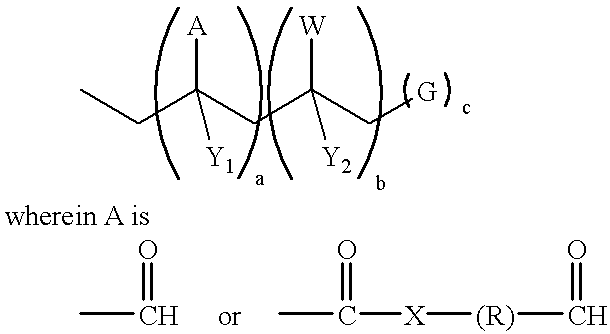Soft, bulky single-ply tissue having a serpentine configuration and low sidedness
- Summary
- Abstract
- Description
- Claims
- Application Information
AI Technical Summary
Benefits of technology
Problems solved by technology
Method used
Image
Examples
example 2
Three one-ply tissue base sheets were produced on a pilot paper machine, as set forth in Example 1, from a furnish containing 50% Northern Softwood Kraft, 50% Northern Hardwood Kraft. Two of the base sheets were made at a targeted basis weight of 19 lbs. per 3000 square foot ream, the third as a targeted weight of 21 lbs. per 3000 square foot ream. All three basis sheets were made to the same tensile targets. Where necessary, a cationic potato starch was added to the softwood kraft portion of the furnish to control the sheet strength. All of the base sheets were treated with a spayed softening compound in the amount of 2.5 lbs. of softener (Quasoft.RTM. 218) per ton of fiber. The softener was applied to the Yankee side of the sheet while the sheet was on the felt shown in FIG. 1 from position 53. For one of the sheets made at the targeted basis weight of 19 lbs. / ream (Product 1, below), a temporary wet strength agent, glyoxal, was applied to the sheet in the amount of 5 lbs. per ton...
example 3
A one-ply tissue base sheet was produced on a pilot paper machine, as set forth in Example 1, from a furnish containing 50% Southern Softwood Kraft, 50% Southern Hardwood Kraft at a targeted basis weight of 19 lbs. per 3000 square foot ream. A cationic potato starch was added to the softwood raft portion of the furnish in the amount of 5.5 lbs. of starch per ton of fiber to control the sheet strength. The base sheet was treated with a sprayed softening compound in the amount of 2.5 lbs. of softener (Quasoft.RTM. 218) per ton of fiber. The softener was applied to the Yankee side of the sheet while the sheet was on the felt as shown in FIG. 1 from position 53. A temporary wet strength agent, glyoxal, was applied to the sheet in the amount of 5 lbs. of wet strength agent per ton of fiber. This was applied as shown in FIG. 1 from position 52. The base sheet was made using a crepe p age of 25% and exhibited a MD stretch value of 27.8%. The base sheet was converted to a 280 count finished...
example 4
The European Patent Application 95302013.8 describes a soft, single-ply tissue that has low sidedness. That product employs such strategies as fiber and / or chemical stratification, aggressive creping, a low creping angle and embossing the product's attributes. The novel tissues disclosed herein have properties superior to those of the aforementioned references and have properties which are similar to two-ply tissue or TAD produced tissue. For example, the tissue of the current invention has a relatively high level of temporary wet strength that is absent in the tissue of the prior art. Also, use of the current invention allows the production of premium CWP one-ply tissues without the use of fiber stratification. It is, of course, understood that fiber stratification could be used to create even better products; however, such a practice has been found to be unnecessary to achieve products that match the performance of the best commercial two-ply CWP and one-ply TAD tissue products.
Th...
PUM
| Property | Measurement | Unit |
|---|---|---|
| Weight | aaaaa | aaaaa |
| Percent by mass | aaaaa | aaaaa |
| Percent by mass | aaaaa | aaaaa |
Abstract
Description
Claims
Application Information
 Login to View More
Login to View More - R&D
- Intellectual Property
- Life Sciences
- Materials
- Tech Scout
- Unparalleled Data Quality
- Higher Quality Content
- 60% Fewer Hallucinations
Browse by: Latest US Patents, China's latest patents, Technical Efficacy Thesaurus, Application Domain, Technology Topic, Popular Technical Reports.
© 2025 PatSnap. All rights reserved.Legal|Privacy policy|Modern Slavery Act Transparency Statement|Sitemap|About US| Contact US: help@patsnap.com



